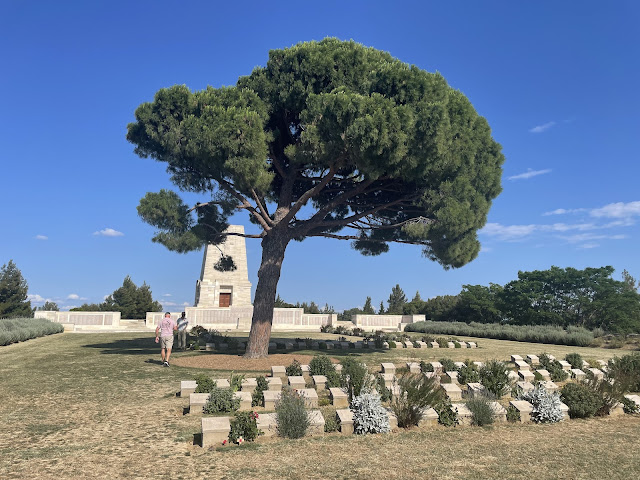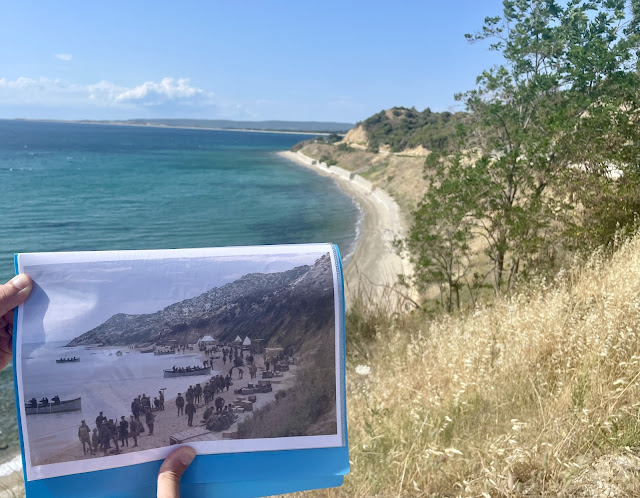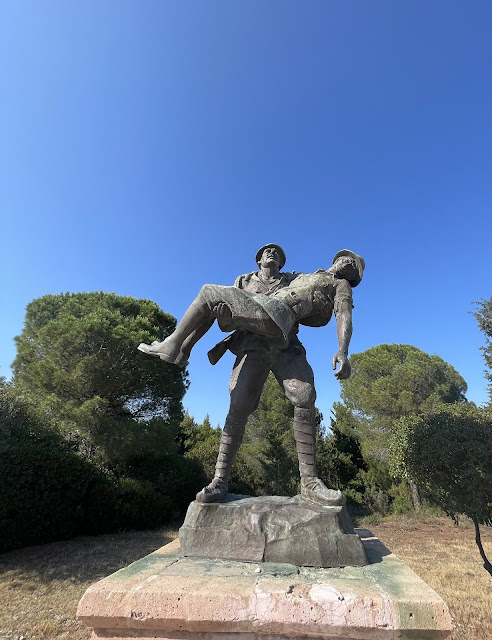Mike's Account of our day trip to Gallipoli
After moving to Australia in 1982 from the UK, it wasn’t long before I heard the term ANZAC. Or more precisely, “bronzed ANZAC”. My new employer was describing a fit looking, suntanned student undertaking his basic dive course in Melbourne, Victoria. I smiled, not sure what this strange sounding word meant, but not long afterwards I saw the movie Gallipoli starring Mel Gibson (spoiler alert) where the Australian Light Horse make its fateful charge at The Neck against well prepared Turkish defenders.
From that moment on, my new Australian life was subjected to regular Gallipoli education. This education was reinforced every 25th April, ANZAC Day, where Australia remembers its inaugural campaign of the First World War. The fact this was a disaster, and Gibson’s movie, plus others since, have reinforced it as such, this is still a revered day within Australia. My only comparison at the time was Remembrance Day each November 11th.
I had served in the Royal Navy and marched on Remembrance Day, but in the late seventies, in the UK, this very important date didn’t (from memory) hold the same weight, the same level of pride as ANZAC Day did for Australians. What’s more, between 1982 and today, I have seen that pride and the public support of it grow each year.
Every ANZAC Day names such as Lone Pine, The Sphinx, ANZAC Cove, Suvla Bay, The Neck and The Dardanelles have been repeated often in speech’s, in movie re-runs and in song - Google Eric Bogle “And the Band Played Waltzing Matilda”, or “Song for Grace” by Sara Storer to get a feel for the level of emotion.
 |
| Lone Pine |
You can possibly imagine my anticipation then, when earlier this year in late June, I got to make an Australian rite of passage with Mandy, her sister and our brother-in-law Lloyd, when we commenced a road trip from Istanbul to Gallipoli. We also visited Troy, just around the corner so-to-speak, which was very interesting, but I’ll let Mandy talk about that.
An important part of my Gallipoli education had been a reinforcement that “The bloody Poms (British) were sitting on the beach drinking tea as Aussies were being slaughtered.” I accepted this on face value, but it was very inaccurate when taken into full perspective. What’s more, the often reported loss of life to Australians rarely mentioned the loss of life to the British and other nations fighting there - Apart from New Zealand, I never knew that other countries had been involved. Indeed, Mel Gibson’s movie implied it was Aussies, Kiwis and Poms and that the Aussies were hit hardest. Factual statistics differ:
Australia - 8,709 killed
France - 9,000 killed
New Zealand - 3,431 killed
India - 1,600 killed
Britain - 31,389 killed
Turkey - 85,000 killed (at least…)
As we crossed the Dardanelles waterway from the town of Cannakkale (pronounced ‘Chan-ak-kal-lee”) to the Gallipoli Peninsular, I noticed a huge sign painted on a cliff. It read, March 18, 1915. This, I found out, is a very significant date for Turkish people. On this day they defeated the Royal Navy in the Dardanelles where, with much lesser forces, they sent the British away with a very bloody nose. This incredible feat should have reinforced the old adage, “one man defending his home is worth ten pressed-men”, but the instigator of this attack to take control of the Dardanelles and ultimately Constantinople, Winston Churchill, wasn’t to be stopped. Therefore his goal to open up a new front via invasion of what was then Ottoman land would continue - the Ottomans had indeed sided with Germany, but if you read ‘Ataturk’ by Kinross, you will see the British influenced this decision with political neglect and an arrogance of Empire.
ANZAC Cove with Suvla Bay at top. The Dardanelles waterway is to the right.
Approximately five weeks later on the 25th of April, the Australian and New Zealand Army Corps (ANZACs) landed, along with the the British, French and Indians, at strategic points to take control of the peninsular. Thanks to the Royal Navy’s failure though, the Turks were as well prepared as they could have been under the command of Colonel Mustafa Kemal. Under Kemal’s inspired leadership the British lead Gallipoli campaign faltered and ultimately failed, with all ‘enemy’ forces withdrawing under cover of darkness 10 months, 3 weeks and 2 days after landing.
Our guide had the driver stop our van next to a small beach where there were headstones and well maintained flowerbeds. Up to our right was steeply rising terrain and, “Shit!” I exclaimed internally, that’s ANZAC Cove and that’s the Sphinx!
Standing high above us was a prominent rocky outcrop, weathered, but immediately recognisable as I had first seen it in the Mel Gibson movie. And the small beach of ANZAC Cove reminded me of a beach near Black Rock on Melbourne’s Port Phillip Bay. These thoughts passed in a flash as my eyes focused on the gravelly beach with its gently lapping waves. I no longer heard our guide’s words, I left the others and climbed down a low wall to the beach. As my feet crunched on the sand and gravel, I pictured ANZACs coming ashore, terrified, so far from home, bullets zipping past as they attempted to find cover.
Although not ever a soldier, it didn’t take much imagination to see the impossible challenge the ANZACs faced that morning. But face it they did, and before the end of the first day a small force had past the Sphinx despite lack of coordinated support, and they had the Turks on the run. This is when Mustafa Kemal gave his famous order to retreating troops, “I don’t expect you to fight for your country, I expect you to die for your country” He qualified this by further explaining that the more of us they kill and the time it takes them to do this, means the more time we have to get reinforcements into position. I have no doubt that Kemal’s orders and his men’s heroic actions saved the Turkish people that day.
Walking amongst the headstones, reading the names, looking at the ages of the ANZACs produced a slight welling-up that I pushed down and covered with placement of sunglasses. I hadn’t expected this moment to be so powerful, but as we continued the tour it only became stronger.
 |
| Mike and Karen trying to take it all in |
Our guide’s knowledge was incredible. In fact, as is required for all guides in Turkey, he was university educated and has been taking tours for over 17 years, “Have you heard of Billy Sing” he asked. I, slightly embarrassed, said no. “Well, he was Australia’s greatest sniper at Gallipoli.” The guide went on to explain the Turks credited him with 300 confirmed “kills” (Australia credits 150, possibly 200) and that he had killed their best sniper. He also explained that on return to Australia, Sing was hardly recognised and died in poverty.
The guide pointed out prominent features off the side of the narrow road too, “See where the land rises up between the trees over there, that is a mass grave of Turkish soldiers”. He also pointed out newer areas where many bedside-table-sized boulders painted white are spaced out evenly to symbolise Turkish soldiers, the white boulder representing the cone-shaped helmets worn by the Turks. Until recent times, there were no Turkish cemeteries, as the sentiment is that it is disrespectful to walk on the ground containing the dead. However, authorities came to realise that it is important for Turkish visitors to have memorials as well, thus the new boulder cemeteries. Generally though, there are thousands of bodies of Turkish soldiers lying where they fell, covered for over 100 years.
We arrived at a high point of land with a view down to Suvla Bay in the distance. This was where a British commander’s gross incompetence contributed to the deaths of thousands of soldiers. The commander’s lack of awareness, perhaps arrogance about the imperative for speed allowed the Turks to get defences prepared. The resultant battle was a one sided slaughter. As I was absorbing this, the guide pointed out that we were at The Neck. From our position, he pointed across the road, a distance of a hundred meters, maybe more, and told us that was where the Turkish trenches were. This was, as the name implies, a very narrow stretch of land. Images from Gallipoli movies, reinforced with the reality of where I was standing hit home. Staring across this once barren, now partially tree covered space, I imagined the first wave of ANZACs leaving their trenches to be immediately cut down, and then the successive waves meeting the same fate as they attempted to charge forward. As I scanned the area ahead of me the power of ANZAC Day speeches, plus memories of a mate I had lost during the Falklands war, another in a military helicopter crash in Indonesia, along with recollections from Australian mates about loss during actions in Iraq and Afghanistan came crashing into focus.
 |
| New Zealand Memorial and Colonel Kemal Mustafa (Ataturk) Statue on Chunuk Bair |
We continued to Chunuk Bair where Kiwi soldiers had reached the high ground and had views of the Dardanelles after a virtually unposed assault thanks to an accurate naval bombardment. Lack of reinforcements/resupply though, saw the Turks retake the position with the loss of over 400 kiwis. In passing at this area, our guide pointed out that he had never had a French person visit Gallipoli. Considering their loss of life was similar to Australia’s, I find this extraordinary, but perhaps can be given perspective considering the losses on their own soil. In comparison, it is now compulsory for all Turkish citizens to visit Gelibolu (Gallipoli) at least once in their lifetime, with free flights provided to those across the country, including school children..
The Gallipoli visit was incredible, especially getting the Turkish perspective of the campaign. A relatively new museum is very worthwhile and reminded me of a mini version of Australia’s War Memorial. Our guide had suggested 6 days to gain most from it, this included new activities of diving on wrecks*, bush walks through the battle sites etc. In our few hours we hardly scratched the surface and I would have loved to have seen more, but am very glad I have walked on the land where the ANZAC legend began.
 |
| Part of a diorama at the Gallipoli War Museum |
*Our guide told us that before the 100th anniversary in 2015, the Turkish navy was instructed to check the waters off ANZAC Cove as there were plans for cruise ships to anchor there and the area hadn’t been surveyed for depth etc. This was a good decision, as their navy divers located over 90 mines and other ordnance! They stopped searching and the Turkish government requested the cancellation of plans for cruise ships to anchor near Anzac Cove.































